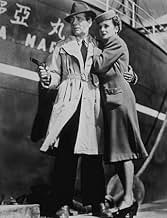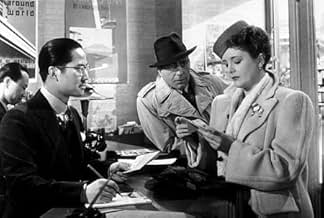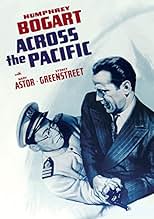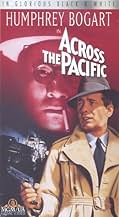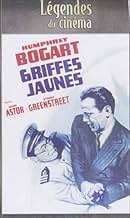1941, el ex capitán del ejército Rick Leland aborda un barco japonés que se dirige a Asia a través del Canal de Panamá, donde sus anfitriones japoneses muestran interés en los planes de defe... Leer todo1941, el ex capitán del ejército Rick Leland aborda un barco japonés que se dirige a Asia a través del Canal de Panamá, donde sus anfitriones japoneses muestran interés en los planes de defensa estadounidenses para la zona del canal.1941, el ex capitán del ejército Rick Leland aborda un barco japonés que se dirige a Asia a través del Canal de Panamá, donde sus anfitriones japoneses muestran interés en los planes de defensa estadounidenses para la zona del canal.
- Dirección
- Guionistas
- Elenco
- Premios
- 1 premio ganado y 1 nominación en total
- Joe Totsuiko
- (as Sen Young)
- Sam Wing On
- (as Lee Tung Foo)
- Dirección
- Guionistas
- Todo el elenco y el equipo
- Producción, taquilla y más en IMDbPro
Opiniones destacadas
Rick Leland (Humphrey Bogart) is court-marshaled and booted out of the service; he then heads for Canada and attempts to enlist, but the Canadians know who he is and say they can't use him.
Leland then leaves on a Japanese ship for the Orient, making no bones about the fact that his talents are for sale! He meets an attractive woman, Alberta Marlow (Mary Astor) and one Dr. Lorenz (Sidney Greenstreet). Lorenz loves the Japanese and its people, and speaks the language very well.
You'll probably guess most of this.
This is a Maltese Falcon template, with the exception of the absence of Peter Lorre. John Huston directed, but when we entered the war, he left to do documentary films for the government. Vincent Sherman started the film at a difficult moment in the action, and he asked Huston how a particular situation would be resolved. Huston said, "That's your problem!" and left.
Originally this film had to do with stopping an attack on Pearl Harbor, but we all know what happened there, so the plot was changed to the Panama Canal.
I liked this film - there is a lot of light repartee between Bogart and Astor, which is fun and makes the film less intense than it might have been. They worked very well together. And you really can't beat Sidney Greenstreet when it comes to being slimy.
The majority of the Japanese in the movie were actually Chinese since most of the Japanese were interred, a black mark not often discussed, which is odd.
Some exciting action and solid work by all the cast.
This was a good performance by Bogart, along with good performances from Astor and Greenstreet. (For those not entirely familiar with Canadian geography, by the way, the pun is that Alberta claims to be from Medicine Hat, which is a small city in Alberta - almost TOO cute!) There's a fair amount of tension throughout as we struggle along with Leland to figure out exactly what's going on, and a nice climax as Leland foils the Japanese plan (Bogey had to win!)
A couple of things I thought were worth noting, though. First of all, what's with the title? All the action in the movie takes place either on the Japanese freighter as it travels south down the ATLANTIC coast of North America or in the Panama Canal Zone (with some minor scenes in Halifax, where Leland is rejected by the Canadian Army, and in New York City, where he snoops for information.) The only Pacific connection to the movie is that the freighter was Japanese. And remember, of course, that this was made in 1942 (after Pearl Harbour.) The depiction of the Japanese isn't especially flattering (although I thought it was more a play on stereotypes than openly antagonistic), and the closing shot of the film is the wartime requisite showing off of American military strength.
All in all, though, I enjoyed this movie immensely, and would highly recommend it.
8/10
It may be unfair to compare "Across the Pacific" to a lucky shot like "The Maltese Falcon," but this film invites the comparison. Not just the same performers but similar lines -- "You're good, Angel, very, very good." But in Falcon the actors fit their fictional characters like enzymes accommodating themselves to a substrate. Here they are just actors playing familiar roles: the obese villain, the officer who's dishonorable discharge is faked so he can go undercover (Gary Cooper could have done as well, and in fact DID in a later movie), the innocent woman made to look bad because the enemy has imprisoned her dissolute father. The Japanese are all plain-vanilla bad guys, even the familiar young one who makes amusing wisecracks in American slang. And all the Japanese have real names like Tong, Chan, Loo, Fong, and Ahn. (To be fair, the last one is Korean, not Chinese.)
If the characters are not nearly as much fun to watch as in "The Maltese Falcon," the plot is no more than a simple war-time mystery involving secret information that the Japanese want to use to start the war by torpedoing the locks of the Panama Canal. Actually, the Japanese did develop such plans later in the war. They intended to deliver a handful of torpedo planes to the vicinity of the Canal in huge submarines, which were available. The planes were not, and the plans folded when the war ended.
In the movie, the characters move from New York to Canada, then board a Japanese steamer, back to New York, then to Panama, where they disembark. They travel from the Atlantic side of the canal to the Pacific -- but they never make it across the Pacific.
You're going to really enjoy this film if you've seen modern Pulp adventures like the Indiana Jones trilogy or Sky Captain (though don't expect to see ANY mystical/sci-fi elements involved). This has it all: a hard-boiled hero, exotic locales, constant plot twists and turns, colorful villains, and a mysterious woman.
Bogart, as (almost) always plays the same character he always plays. but boy, does he fit in SO well into this film. Mary Astor, while not the pretty face that she was built up to be here and in "The Maltese Falcon", gives another great performance, and unlike Bogart, she was always able to give characters in a similar vein (in this case, the mysterious woman), each their own personalities. Her Alberta Marlow is not at all like "schoolgirl" Brigid O'Shaughnessey, but (at least openly) tougher, a perfect match with Bogart during their exchanges of dialogue, while remaining to be extremely ambiguous, never making sure whether or not she's an ally or a femme fatale. When all is revealed, looking back on it things made perfect sense with her character's attitude.
Sydney Greenstreet adds another great villain to his own rogues gallery. Here he's a man obsessed with Japanese culture and way of life, so much that he has become apart of and accepted by "the enemy". Victor Sen Young, who played a great shark grinned scumbag in "The Letter", does good here, looking very happy that he at least was able to speak coherently for once in a motion picture.
Huston's direction is really worth looking at, especially visually stunning during a sequence at a movie theater. Without his obvious presence and Bogart, this film would have just been another propaganda story of espionage. Sadly, when he had to leave the film for war duty, the final scenes were shot by otherwise competent (but nothing special) director Vincent Sherman. The final 15 minutes seem extremely out of place with the rest of the film, and its a shame Huston wasn't around a little bit longer to round up what could have been a quintessential piece of a feature 40's pulp movie.
Worth seeing, its a film that falls short of greatness, but man is it entertaining.
¿Sabías que…?
- TriviaDirector Vincent Sherman met with John Huston just before Huston left the project to join the United States Army Signal Corps to shoot documentaries for the war effort.
The two directors conferred just before they were about to shoot the scene in which Leland is trapped in the movie theatre and three assassins are trying to kill him.
"How does he get out?" Sherman asked. Huston replied, "That's your problem! I'm off to the war!"
John Huston then went off to join the war effort before the film was finished, taking the film script with him, explaining "Bogie will know how to get out." The studio's solution to the problem was to discard Huston's footage of the impossible dilemma and write a new scenario. Vincent Sherman directed the final scenes.
- ErroresThe background for the opening titles is a map of the Panama Canal. The orientation of the map and the compass is correct, but the labeling of the map is incorrect. In fact, the Atlantic end of the canal and the city of Colon are at the upper left (Northwest), and the Pacific end of the canal and Panama City are at the lower right (Southeast). The map is correctly labeled behind the closing credits.
- Citas
Rick Leland: [comparing his gun to Dr. Lorenz's, which he points at him] Remember: mine is bigger than yours!
- Créditos curiososOpening Card:
Governor's Island
New York
- Versiones alternativasAlso available in a computer colorized version.
- ConexionesFeatured in Frances Farmer Presents: Across the Pacific (1959)
Selecciones populares
- How long is Across the Pacific?Con tecnología de Alexa
Detalles
- Fecha de lanzamiento
- País de origen
- Idiomas
- También se conoce como
- Across the Pacific
- Locaciones de filmación
- Productora
- Ver más créditos de la compañía en IMDbPro
- Tiempo de ejecución
- 1h 37min(97 min)
- Color
- Relación de aspecto
- 1.37 : 1


